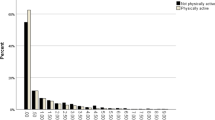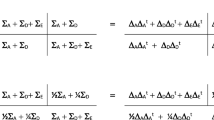Abstract
Despite the high heritability of children’s activity level, which forms part of the core symptom domain of hyperactivity-impulsivity within attention deficit hyperactivity disorder (ADHD), there has only been a limited success with identifying candidate genes involved in its etiology. This may reflect a lack of understanding about the different measures used to define activity level across studies. We aimed to study the genetic and environmental etiology across three measures of activity level: parent and teacher ratings of hyperactivity-impulsivity and actigraph measurements, within a population-based sample of 463 7–9 year old twin pairs. We further examined ways in which the three measures could be combined for future molecular studies. Phenotypic correlations across measures were modest, but a common underlying phenotypic factor was highly heritable (92%); as was a simple aggregation of all three measurements (77%). This suggests that distilling what is common to all three measures may be a good method for generating a quantitative trait suitable for molecular studies of activity level in children. The high heritabilities found are encouraging in this respect.



Similar content being viewed by others
References
Abikoff H, Courtney M, Pelham WE Jr, Koplewicz HS (1993) Teachers’ ratings of disruptive behaviors: the influence of halo effects. J Abnorm Child Psychol 21(5):519–533
Asherson P (2004) Attention-deficit hyperactivity disorder in the post-genomic era. Eur Child Adolesc Psychiatry 13(Suppl 1):I50–I70
Bird HR, Gould MS, Staghezza BM (1993) Patterns of diagnostic comorbidity in a community sample of children aged 9 through 16 years. J Am Acad Child Adolesc Psychiatry 32(2):361–368
Conners CK, Sitarenios G, Parker JD, Epstein JN (1998a) The revised Conners’ Parent Rating Scale (CPRS-R): factor structure, reliability, and criterion validity. J Abnorm Child Psychol 26(4):257–268
Conners CK, Sitarenios G, Parker JD, Epstein JN (1998b) Revision and restandardization of the Conners Teacher Rating Scale (CTRS-R): factor structure, reliability, and criterion validity. J Abnorm Child Psychol, 26(4):279–291
Dane AV, Schachar RJ, Tannock R (2000). Does actigraphy differentiate ADHD subtypes in a clinical research setting?. J Am Acad Child Adolesc Psychiatry 39(6):752–760
DuPaul GJ (2003) Assessment of ADHD symptoms: comment on Gomez et al. (2003). Psychol Assess 15(1):115–117
Eaton WO, McKeen NA, Saudino KJ (1996) Measuring human individual differences in general motor activity with actometers. In K Ossenkopp, M Kavaliers, PR Sanberg (Eds), Measuring movement and locomotion: from invertebrates to humans. R. G. Landes Co, Austin, TX (pp. 79–92)
Eaves LJ, Silberg JL, Meyer JM, Maes HH, Simonoff E, Pickles A et al (1997) Genetics and developmental psychopathology: 2. The main effects of genes and environment on behavioral problems in the Virginia Twin Study of Adolescent Behavioral Development. J Child Psychol Psychiatry 38(8):965–980
Eaves L, Rutter M, Silberg JL, Shillady L, Maes H, Pickles A (2000) Genetic and environmental causes of covariation in interview assessments of disruptive behavior in child and adolescent twins. Behav Genet 30(4):321–334
Faraone SV, Doyle AE,Mick E, Biederman J (2001) Meta analysis of the association between the 7-repeat allele of the dopamine D(4) receptor gene and attention deficit hyperactivity disorder. Am J Psychiatry 158:1052–1057
Faraone SV, Sergeant J, Gilberg C, Biederman J (2003) The world wide prevalence of ADHD: is it an American condition? World Psychiatry 2:104–113
Faraone SV, Perlis RH, Doyle AE, Smoller JW, Goralnick JJ, Holmgren MA, et al (2005) Molecular genetics of attention-deficit/hyperactivity disorder. Biol Psychiatry 57(11):1313–1323
Foley DL, Eaves LJ, Wormley B, Silberg JL, MaesHH, Kuhn J et al (2004) Childhood adversity, monoamine oxidase a genotype, and risk for conduct disorder. Arch Gen Psychiatry 61(7):738–744
Ford T, Goodman R, Meltzer H (2003). The british child and adolescent mental health survey 1999: the prevalence of DSM-IV disorders. J Am Acad Child Adolesc Psychiatry 42(10):1203–1211
Gjone H, Stevenson J, Sundet JM (1996) Genetic influence on parent-reported attention-related problems in a Norwegian general population twin sample. J Am Acad Child Adolesc Psychiatry 35(5):588–596; discussion 596–588
Goldsmith HH, Hewitt EC (2003) Validity of parental report of tempermant: distinctions and needed research. Infant Behav Dev 26:108–111
Goodman R, Stevenson J (1989) A twin study of hyperactivity–II. The aetiological role of genes, family relationships and perinatal adversity. J Child Psychol Psychiatry 30(5):691–709
Holmes J, Payton A, Barrett J, Harrington R, McGuffin P, Owen M et al. (2002). Association of DRD4 in children with ADHD and comorbid conduct problems. Am J Med Genet, 114(2):150–153
Inoue K, Nadaoka T, Oiji A, Morioka Y, Totsuka S, Kanbayashi Y et al (1998) Clinical evaluation of attention-deficit hyperactivity disorder by objective quantitative measures. Child Psychiatry Hum Dev 28(3):179–188
Kuntsi J, Stevenson J (2001). Psychological mechanisms in hyperactivity: II. The role of genetic factors. J Child Psychol Psychiatry 42(2):211–219
Kuntsi J, Oosterlaan J, Stevenson J (2001) Psychological mechanisms in hyperactivity: I. Response inhibition deficit, working memory impairment, delay aversion, or something else? J Child Psychol Psychiatry 42(2):199–210
Kuntsi J, Neale BM, Chen W, Faraone SV, Asherson P (2006) The IMAGE project: methodological issues for the molecular genetic analysis of ADHD. Behav Brain Funct 2(1):27
Kuntsi J, Rogers H, Swinard G, Borger N, Meere J, Rijsdijk F et al (2006) Reaction time, inhibition, working memory and ‘delay aversion’ performance: genetic influences and their interpretation. Psychol Med 36(11):1613–1624
Langley K, Marshall L, van den Bree M, Thomas H, Owen M, O’Donovan M et al (2004) Association of the dopamine D4 receptor gene 7-repeat allele with neuropsychological test performance of children with ADHD. Am J Psychiatry 161(1):133–138
Loehlin JC (1996). The Cholesky approach: a cautionary note. Behav Genet 26(1):65–69
Martin N, Scourfield J, McGuffin P (2002) Observer effects and heritability of childhood attention-deficit hyperactivity disorder symptoms. Br J Psychiatry 180:260–265
McGrath AM, Handwerk ML, Armstrong KJ, Lucas CP, Friman PC (2004) The validity of the ADHD section of the diagnostic interview schedule for children. Behav Modif 28(3):349–374
Nadder TS, Silberg JL, Rutter M, Maes HH, Eaves LJ (2001) Comparison of multiple measures of ADHD symptomatology: a multivariate genetic analysis. J Child Psychol Psychiatry 42(4):475–486
Neale MC, Boker SM, Xie G, Maes H (2006). Mx: statistical modeling, 7th edn. Department of Psychiatry, VCU Box 900126, Richmond, VA 23298
Porrino LJ, Rapoport JL, Behar D, Ismond DR, Bunney WE Jr (1983a) A naturalistic assessment of the motor activity of hyperactive boys. II. Stimulant drug effects.Arch Gen Psychiatry 40(6):688–693
Porrino LJ, Rapoport JL, Behar D, Sceery W, Ismond DR, Bunney WE Jr (1983b) A naturalistic assessment of the motor activity of hyperactive boys. I. Comparison with normal controls. Arch Gen Psychiatry 40(6):681–687
Price TS, Freeman B, Craig I, Petrill SA, Ebersole L, Plomin R (2000) Infant zygosity can be assigned by parental report questionnaire data. Twin Res 3(3):129–133
Rietveld MJ, Posthuma D, Dolan CV, Boomsma DL (2003) ADHD: sibling interaction or dominance: an evaluation of statistical power. Behav Genet 33(3):247–255
Rijsdijk FV, Sham PC (2002) Analytic approaches to twin data using structural equation models. Brief Bioinform 3(2):119–133
Rothbart MK, Hwang J (2002) Measuring Infant temperament. Infant Behav Dev 25:113–116
Saudino KJ (2002). Parent ratings of infant temperament Lessons from twin studies. Infant Behav Dev 26:100–107
Saudino KJ, Eaton WO (1991) Infant temperament and genetics: an objective twin study of motor activity level. Child Dev, 62(5):1167–1174
Saudino KJ, Cherny SS, Plomin R (2000) Parent ratings of temperament in twins: explaining the ‘too low’ DZ correlations. Twin Res 3(4):224–233
Saudino KJ, Wertz AE, Gagne JR, Chawla S (2004) Night and day: are siblings as different in temperament as parents say they are? J Pers Soc Psychol 87(5):698–706
Saudino KJ, Ronald A, Plomin R (2005) The etiology of behavior problems in 7-year-old twins: substantial genetic influence and negligible shared environmental influence for parent ratings and ratings by same and different teachers. J Abnorm Child Psychol 33(1):113–130
Schachar R, Sandberg S, Rutter M (1986) Agreement between teachers’ ratings and observations of hyperactivity, inattentiveness, and defiance. J Abnorm Child Psychol 14(2):331–345
Sherman DK, McGue MK, Iacono WG (1997) Twin concordance for attention deficit hyperactivity disorder: a comparison of teachers’ and mothers’ reports. Am J Psychiatry 154(4):532–535
Simonoff E, Pickles A, Hervas A, Silberg JL, Rutter M, Eaves L (1998) Genetic influences on childhood hyperactivity: contrast effects imply parental rating bias, not sibling interaction. Psychol Med 28(4):825–837
Spinath FM, O’Connor TG (2003) A behavioral genetic study of the overlap between personality and parenting. J Pers 71(5):785–808
Spinath FM, Wolf H, Angleitner A, Borkenau P, Riemann R (2002) Genetic and environmental influences on objectively assessed activity in adults. Pers Individ Dif 33:633–645
Stevens J, Quittner AL, Abikoff H (1998) Factors influencing elementary school teachers’ ratings of ADHD and ODD behaviors. J Clin Child Psychol 27(4):406–414
Teicher MH, Ito Y, Glod CA, Barber NI (1996) Objective measurement of hyperactivity and attentional problems in ADHD. J Am Acad Child Adolesc Psychiatry 35(3):334–342
Thapar A, Harrington R, Ross K, McGuffin P (2000) Does the definition of ADHD affect heritability? J Am Acad Child Adolesc Psychiatry 39(12):1528–1536
Tripp G, Schaughency EA, Clarke B (2006) Parent and teacher rating scales in the evaluation of attention-deficit hyperactivity disorder: contribution to diagnosis and differential diagnosis in clinically referred children. J Dev Behav Pediatr 27(3): 209–218
Trouton A, Spinath FM, Plomin R (2002) Twins early development study (TEDS): a multivariate, longitudinal genetic investigation of language, cognition and behavior problems in childhood. Twin Res 5(5):444–448
Van Coevering P, Harnack L, Schmitz K, Fulton JE, Galuska DA, Gao S (2005) Feasibility of using accelerometers to measure physical activity in young adolescents. Med Sci Sports Exerc 37(5):867–871
Williams LJ, Holahan PJ (1994) Parsimony based fit indicies for multiple fit indicator models: do they work? Struct Equation Model 1:161–198
Wood AC, Saudino KJ, Rogers H, Asherson P, Kuntsi J (2007) Genetic influences on mechanically-assessed activity level in children. J Child Psychol Psychiatry 48(7):695–702
Acknowledgements
The Study of Activity and Impulsivity Levels in children (SAIL) is funded by a project grant from the Wellcome Trust (GR070345MF). Dr. Saudino is supported by grant MH062375 from the National Institute of Mental Health. Alexis Wood is supported by the Economic and Social Research Council. Thank you to all who make this research possible: the TEDS-SAIL families, who give their time and support so unstintingly; Eda Salih, Hannah Rogers, Rebecca Gibbs, Greer Swinard, Kate Lievesley, Kayley O’Flynn, Suzi Marquis and Rebecca Whittemore, Vlad Mereuţa, Desmond Campbell and everyone on the TEDS team.
Author information
Authors and Affiliations
Corresponding author
Additional information
Edited by Danielle Posthuma.
Rights and permissions
About this article
Cite this article
Wood, A.C., Rijsdijk, F., Saudino, K.J. et al. High Heritability for a Composite Index of Children’s Activity Level Measures. Behav Genet 38, 266–276 (2008). https://doi.org/10.1007/s10519-008-9196-1
Received:
Accepted:
Published:
Issue Date:
DOI: https://doi.org/10.1007/s10519-008-9196-1




